0 前言
上一篇详细学习了Horovod相关知识,因此,这一篇便开始尝试Horovod的实战练习。
实验环境为矩池云的机器,里边提供了打包好的horovod镜像,因此暂未考虑如何安装的问题。
1 单机多卡
1.0 硬件配置
为节省money,使用单机双卡配置
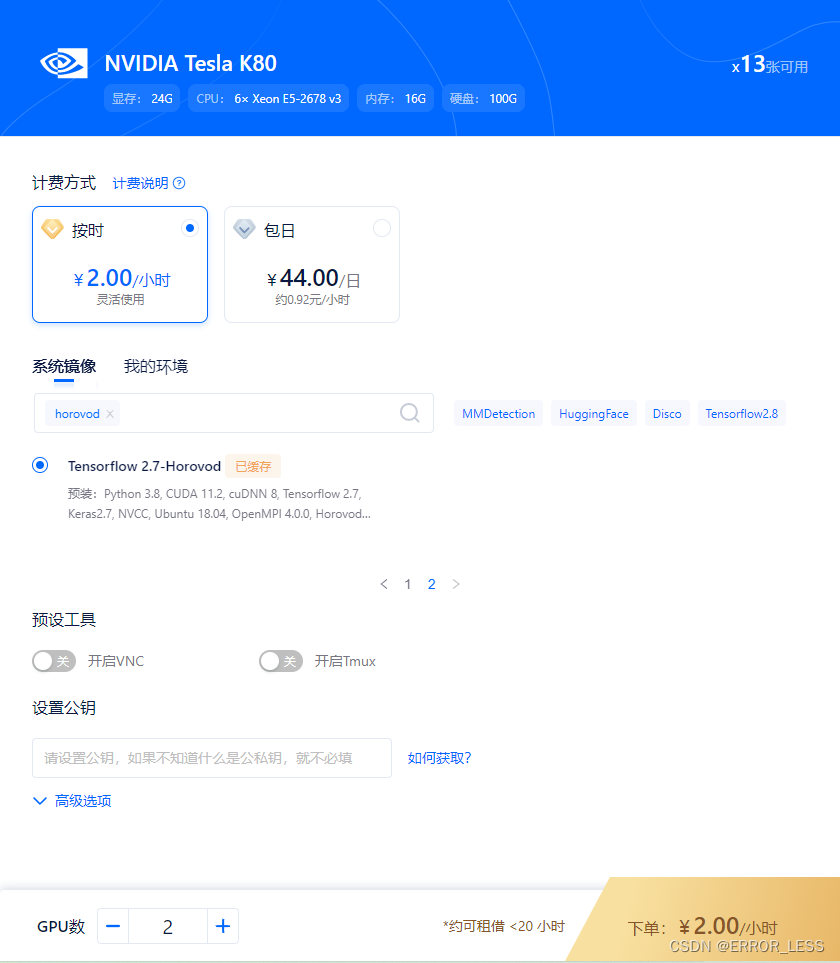
1.1 源码
import sys
import tensorflow as tf
import horovod
import horovod.tensorflow.keras as hvd
def main():
# Horovod: initialize Horovod.
hvd.init()
# Horovod: pin GPU to be used to process local rank (one GPU per process)
gpus = tf.config.experimental.list_physical_devices('GPU')
for gpu in gpus:
tf.config.experimental.set_memory_growth(gpu, True)
if gpus:
tf.config.experimental.set_visible_devices(gpus[hvd.local_rank()], 'GPU')
(mnist_images, mnist_labels), _ = \
tf.keras.datasets.mnist.load_data(path='mnist-%d.npz' % hvd.rank())
dataset = tf.data.Dataset.from_tensor_slices(
(tf.cast(mnist_images[..., tf.newaxis] / 255.0, tf.float32),
tf.cast(mnist_labels, tf.int64))
)
dataset = dataset.repeat().shuffle(10000).batch(128)
mnist_model = tf.keras.Sequential([
tf.keras.layers.Conv2D(32, [3, 3], activation='relu'),
tf.keras.layers.Conv2D(64, [3, 3], activation='relu'),
tf.keras.layers.MaxPooling2D(pool_size=(2, 2)),
tf.keras.layers.Dropout(0.25),
tf.keras.layers.Flatten(),
tf.keras.layers.Dense(128, activation='relu'),
tf.keras.layers.Dropout(0.5),
tf.keras.layers.Dense(10, activation='softmax')
])
# Horovod: adjust learning rate based on number of GPUs.
scaled_lr = 0.001 * hvd.size()
opt = tf.optimizers.Adam(scaled_lr)
# Horovod: add Horovod DistributedOptimizer.
opt = hvd.DistributedOptimizer(
opt, backward_passes_per_step=1, average_aggregated_gradients=True)
# Horovod: Specify `experimental_run_tf_function=False` to ensure TensorFlow
# uses hvd.DistributedOptimizer() to compute gradients.
mnist_model.compile(loss=tf.losses.SparseCategoricalCrossentropy(),
optimizer=opt,
metrics=['accuracy'],
experimental_run_tf_function=False)
callbacks = [
# Horovod: broadcast initial variable states from rank 0 to all other processes.
# This is necessary to ensure consistent initialization of all workers when
# training is started with random weights or restored from a checkpoint.
hvd.callbacks.BroadcastGlobalVariablesCallback(0),
# Horovod: average metrics among workers at the end of every epoch.
#
# Note: This callback must be in the list before the ReduceLROnPlateau,
# TensorBoard or other metrics-based callbacks.
hvd.callbacks.MetricAverageCallback(),
# Horovod: using `lr = 1.0 * hvd.size()` from the very beginning leads to worse final
# accuracy. Scale the learning rate `lr = 1.0` ---> `lr = 1.0 * hvd.size()` during
# the first three epochs. See https://arxiv.org/abs/1706.02677 for details.
hvd.callbacks.LearningRateWarmupCallback(initial_lr=scaled_lr, warmup_epochs=3, verbose=1),
]
# Horovod: save checkpoints only on worker 0 to prevent other workers from corrupting them.
if hvd.rank() == 0:
callbacks.append(tf.keras.callbacks.ModelCheckpoint('./checkpoint-{epoch}.h5'))
# Horovod: write logs on worker 0.
verbose = 1 if hvd.rank() == 0 else 0
# Train the model.
# Horovod: adjust number of steps based on number of GPUs.
mnist_model.fit(dataset, steps_per_epoch=500 // hvd.size(), callbacks=callbacks, epochs=24, verbose=verbose)
if __name__ == '__main__':
if len(sys.argv) == 4:
# run training through horovod.run
np = int(sys.argv[1])
hosts = sys.argv[2]
comm = sys.argv[3]
print('Running training through horovod.run')
horovod.run(main, np=np, hosts=hosts, use_gloo=comm == 'gloo', use_mpi=comm == 'mpi')
else:
# this is running via horovodrun
main()
1.2 运行
horovodrun -np 2 -H localhost:2 python tensorflow2_keras_mnist.py
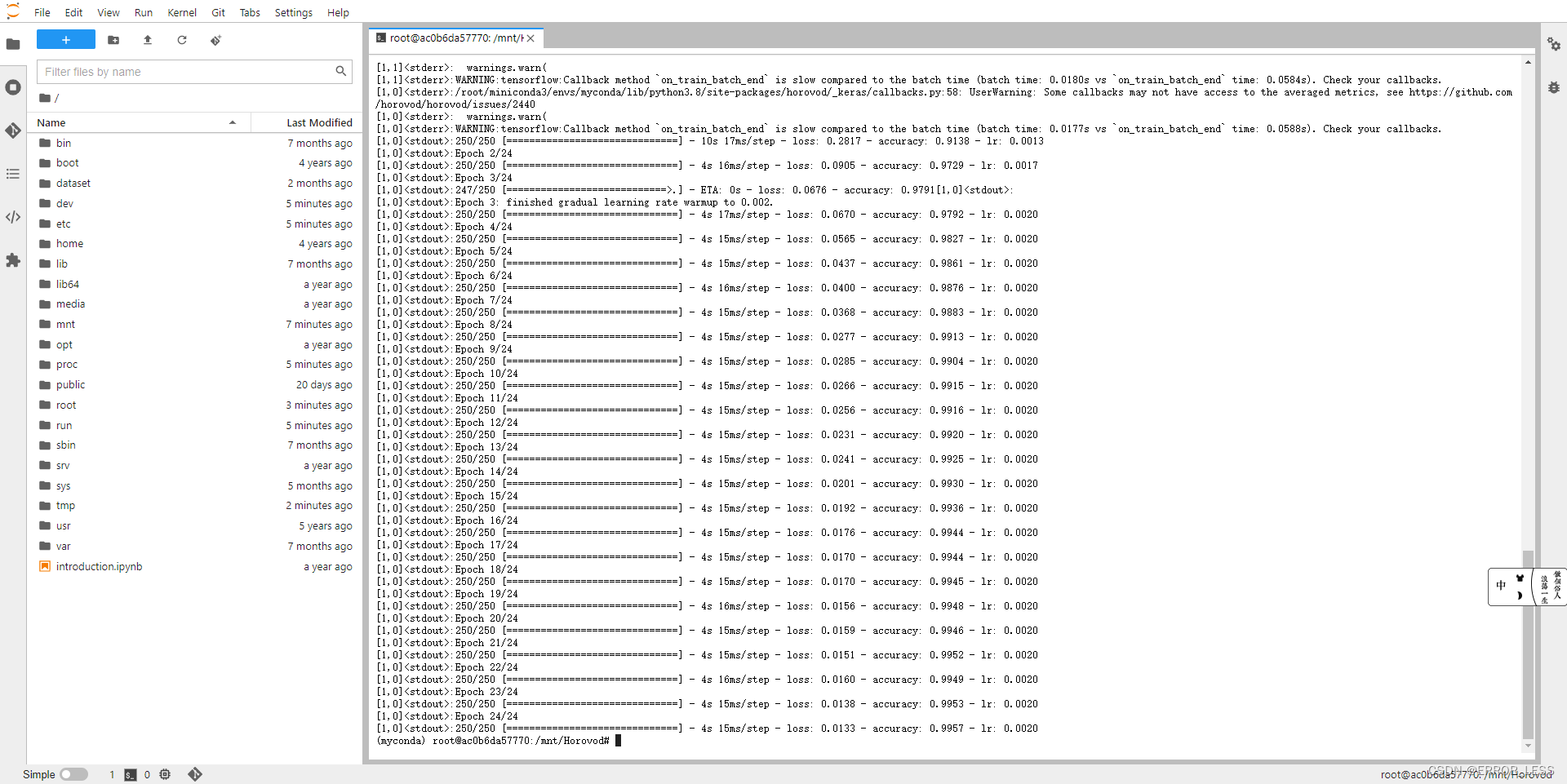
2 多机多卡
2.0 硬件配置
同样本着节约测试成本的考虑,采用了双机双卡的硬件配置。IP分别为192.168.1.37,192.168.1.38。
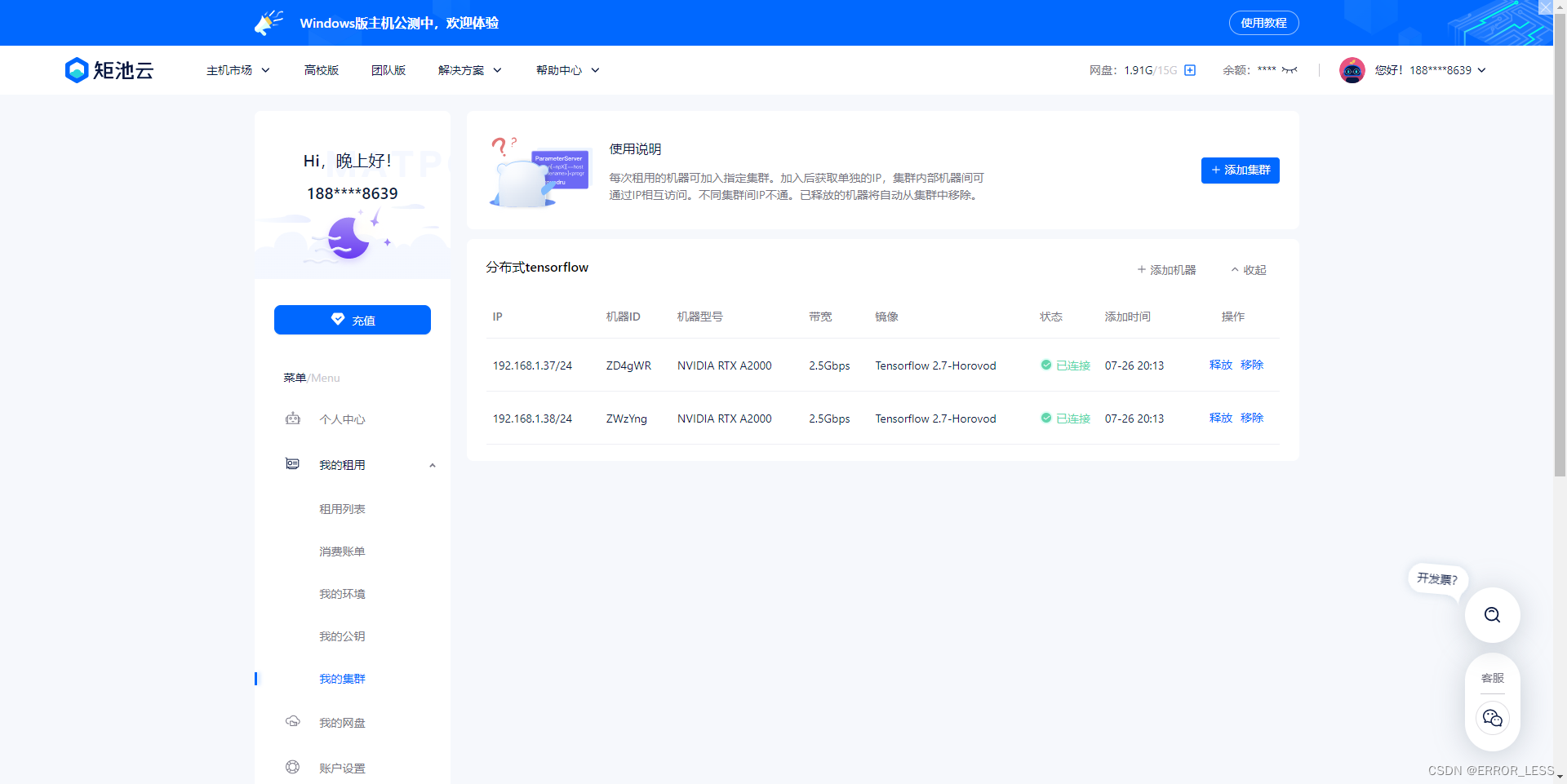
2.1 配置环境
- 登录任一节点进行节点间的ssh连通。
(myconda) root@b0945000424c:/# ssh-keygen -t rsa # 一路enter即可,生成公私钥
Generating public/private rsa key pair.
Enter file in which to save the key (/root/.ssh/id_rsa):
Enter passphrase (empty for no passphrase):
Enter same passphrase again:
Your identification has been saved in /root/.ssh/id_rsa.
Your public key has been saved in /root/.ssh/id_rsa.pub.
The key fingerprint is:
SHA256:rCyXYDDQwFCxn+4SsIGB4vrCyBg9ZK20yXaNlxrZeqk root@b0945000424c
The key's randomart image is:
+---[RSA 2048]----+
|B+o. |
|+o.. |
|+.+. |
|+.++.. . |
|.X +== .S |
|+ Xo=o=o |
|=+ +o==. |
|+oo.ooo |
| . .Eo |
+----[SHA256]-----+
(myconda) root@b0945000424c:/# ssh-copy-id root@192.168.1.37 #分发给其他节点,输入对应秘钥。
/usr/bin/ssh-copy-id: INFO: Source of key(s) to be installed: "/root/.ssh/id_rsa.pub"
The authenticity of host '192.168.1.37 (192.168.1.37)' can't be established.
ECDSA key fingerprint is SHA256:mBoJB3tizC3nKPNphS7AKrsWtjiRt31P2VPuNys+9y4.
Are you sure you want to continue connecting (yes/no)? yes
/usr/bin/ssh-copy-id: INFO: attempting to log in with the new key(s), to filter out any that are already installed
/usr/bin/ssh-copy-id: INFO: 1 key(s) remain to be installed -- if you are prompted now it is to install the new keys
root@192.168.1.37's password:
Number of key(s) added: 1
Now try logging into the machine, with: "ssh 'root@192.168.1.37'"
and check to make sure that only the key(s) you wanted were added.
- 查看两台机器的网卡


- 添加环境变量
两台机器都要执行
(myconda) root@b0945000424c:/# export NCCL_SOCKET_IFNAME=meth811,meth812
(myconda) root@b0945000424c:/# export GLOO_IFACE=meth811,meth812
(myconda) root@b0945000424c:/# export NCCL_DEBUG=INFO #可选,如需获得额外的nccl信息
2.2 运行
-
常规运行
(myconda) root@b0945000424c:/mnt/Horovod# horovodrun -np 2 -H 192.168.1.37:1,192.168.1.38:1 --network-interface "192.168.1.37/24,192.168.1.38/24" python tensorflow2_keras_mnist.py
参数说明:
-np:后面的数字代表指定的总进程数(其实就是总GPU数)
-H:指定各计算节点所运行卡数,格式为 IP:GPU数,多个节点之间逗号隔开,本机的信息也需要配置,所有节点都需要写入。例如 192.168.1.37:1 代表 IP 为 192.168.1.37,有 1 张GPU。
network-interface:指定各计算节点的 IP,需要与 H 的参数对应。

-
如需性能分析,按以下方式运行
(myconda) root@b0945000424c:/mnt/Horovod# horovodrun -np 1 --timeline-filename /path/to/timeline.json python tensorflow2_keras_mnist.py
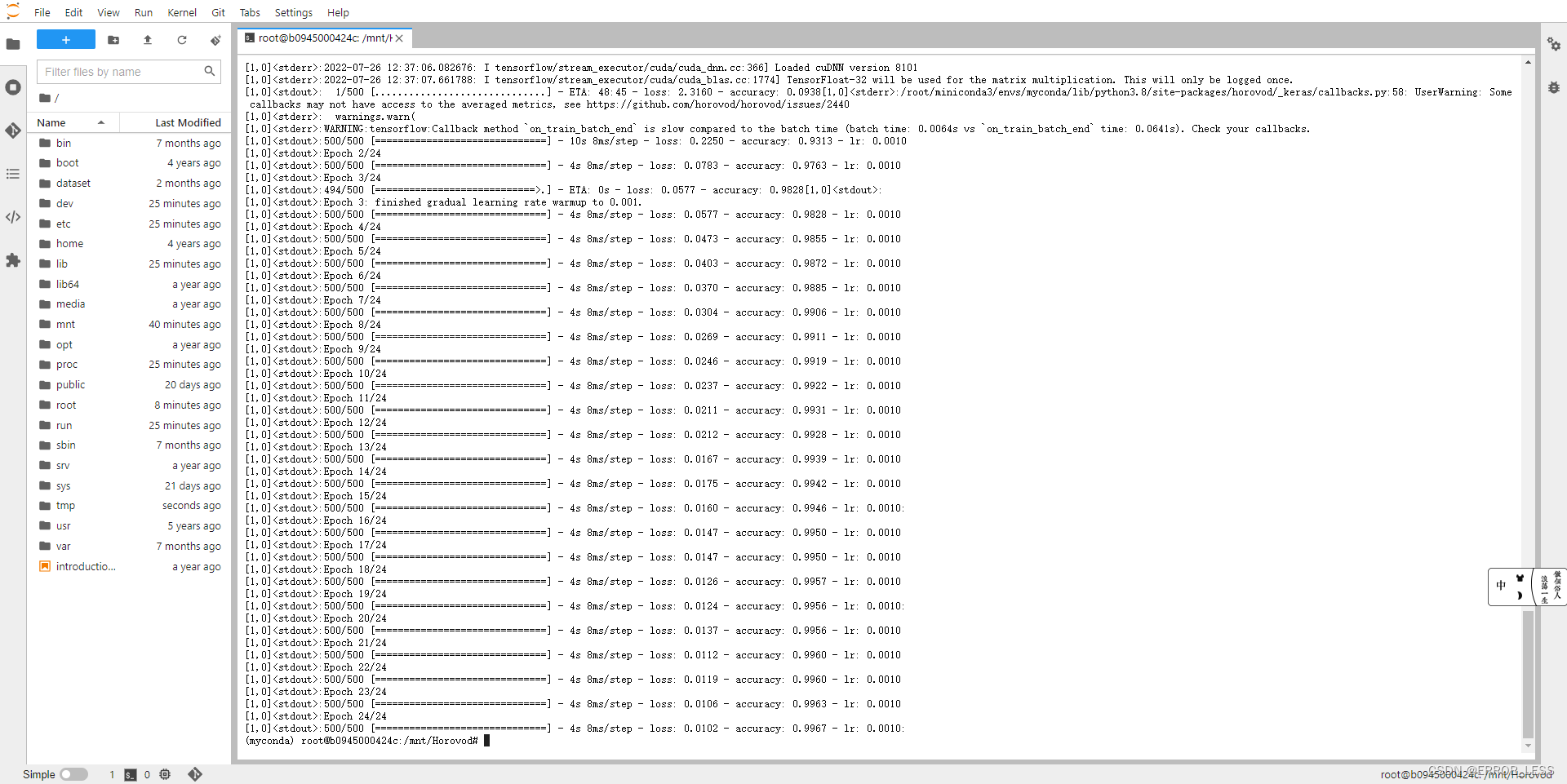
可以在谷歌浏览器的
chrome://tracing/打开时间线文件进行一些性能的跟踪。
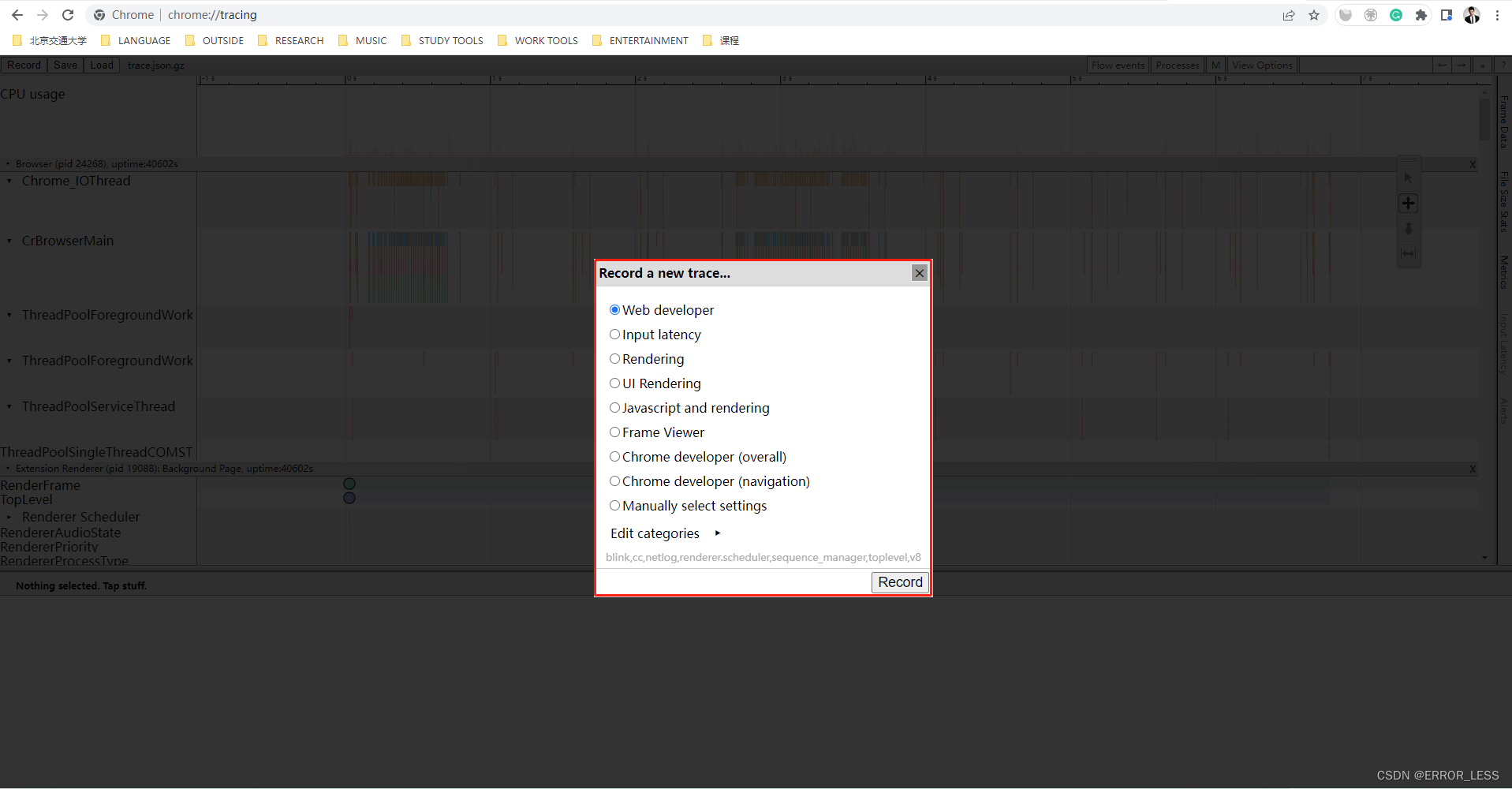
这里不能打开该时间线文件的原因是:源码中并未设置--timeline-filename命令参数,实际上训练完并没有生成时间线文件
查看后发现确实没有这个文件,因此,需在测试源码中添加--timeline-filename这个参数






















 1042
1042











 被折叠的 条评论
为什么被折叠?
被折叠的 条评论
为什么被折叠?








